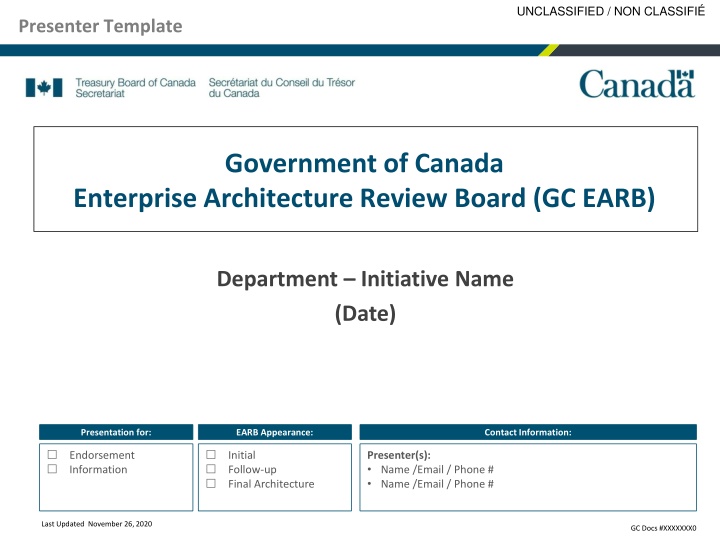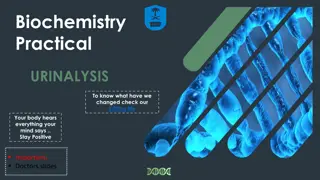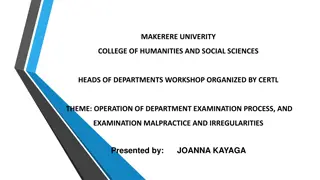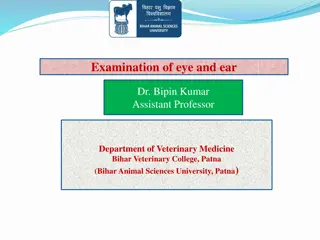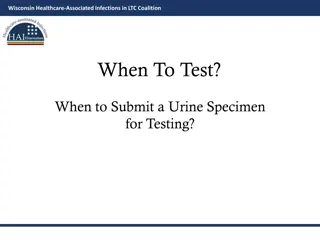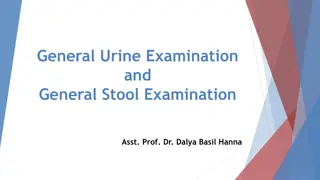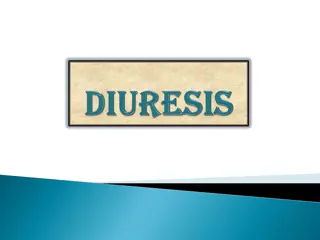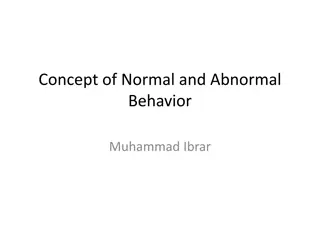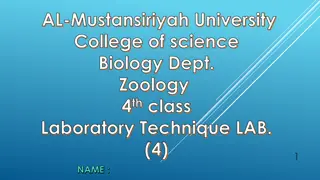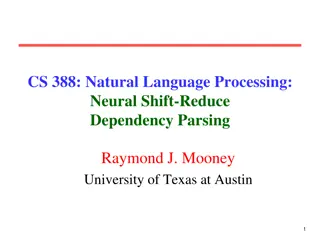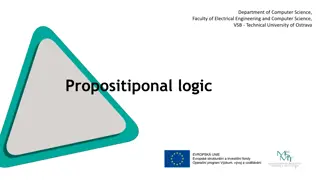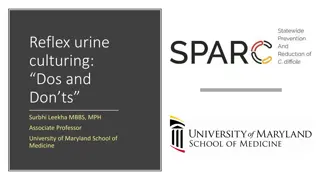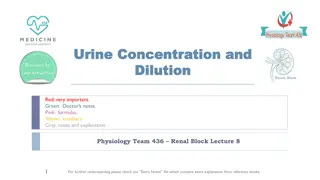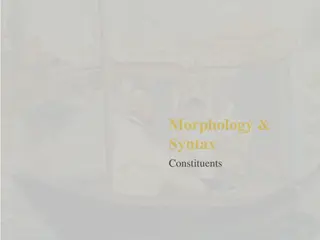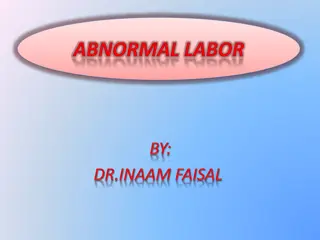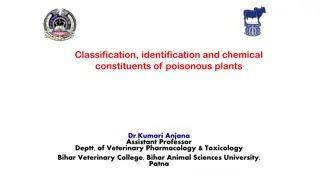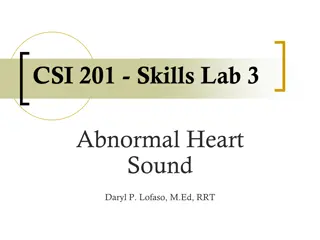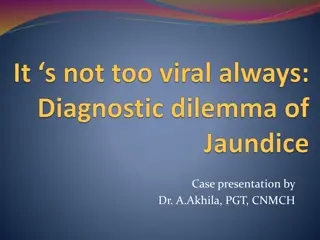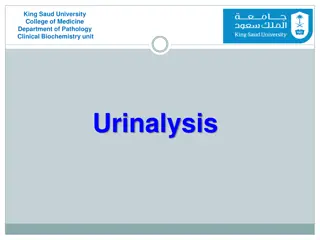Chemical Examination of Urine: Normal vs. Abnormal Constituents
This lecture covers the chemical examination of urine, focusing on differentiating between normal and abnormal constituents such as proteins, sugars, ketone bodies, nitrite, and bile pigments. It explores clinical conditions associated with proteinuria, blood-uria, glycosuria, and more. The content delves into the overview, normal composition, and abnormal composition of urine, including discussions on proteinuria types like pre-renal, renal, and post-renal. Additionally, it explains glycosuria variations, ketonuria, and hematuria causes. Examining urine as a fluid excreted by animals, particularly humans, the lecture explains its formation in the kidneys and the chemical changes it undergoes.
Uploaded on Mar 15, 2025 | 2 Views
Download Presentation

Please find below an Image/Link to download the presentation.
The content on the website is provided AS IS for your information and personal use only. It may not be sold, licensed, or shared on other websites without obtaining consent from the author.If you encounter any issues during the download, it is possible that the publisher has removed the file from their server.
You are allowed to download the files provided on this website for personal or commercial use, subject to the condition that they are used lawfully. All files are the property of their respective owners.
The content on the website is provided AS IS for your information and personal use only. It may not be sold, licensed, or shared on other websites without obtaining consent from the author.
E N D
Presentation Transcript
UNCLASSIFIED / NON CLASSIFI Presenter Template Government of Canada Enterprise Architecture Review Board (GC EARB) Department Initiative Name (Date) Presentation for: EARB Appearance: Contact Information: Endorsement Information Initial Follow-up Final Architecture Presenter(s): Name /Email / Phone # Name /Email / Phone # Last Updated November 26, 2020 GC Docs #XXXXXXX0
UNCLASSIFIED / NON CLASSIFI Purpose of GC EARB Session The purpose of this presentation is to seek GC EARB endorsement of OR The purpose of this presentation is to provide GC EARB information related to 2
UNCLASSIFIED / NON CLASSIFI Request - Background Describe which departmental policies, programs and business services the presentation is addressing. 3
UNCLASSIFIED / NON CLASSIFI Business Capabilities Addressed List the business capabilities addressed with this architecture. Business Capability Model Business Capabilities List the Business capabilities addressed, 2 examples below https://gcconnex.gc.ca/file/download/50303103 2.0 reference material, https://gcconnex.gc.ca/fil e/download/50303103 1. Legislation, Regulation and Policy Management https://gcconnex.gc.ca/file/download/50303103 2. Enterprise Planning 3. Outcomes Management 3.2 Performance Management 4. Relationship Management 4.3 Stakeholder Interaction Management 5. Compliance Management 6. Program and Service Delivery 7. Information Management 8. Government Resources Management 9. Corporate Management 4
UNCLASSIFIED / NON CLASSIFI Current State Architecture Problem Summary Describe the problems with the current architecture. Summary of the business problem as described in the Concept Case Describe the problem in each of the layers of EA Framework: Business, Information, Application, Technology and Security 5
UNCLASSIFIED / NON CLASSIFI Current State Architecture Diagram EXAMPLE 6
UNCLASSIFIED / NON CLASSIFI Target State Architecture Diagram EXAMPLE NEW Identify the old component(s) in GREY and the new component(s) in BRIGHT COLOURS, show zoning and legend. 7
UNCLASSIFIED / NON CLASSIFI Target State Architecture Solution Summary Describe the Target State Architecture. Describe how the target state architecture addresses the business problem stated in the Concept Case Describe the solution in each layer of the EA Framework: Business, Information, Application, Technology and Security 8
UNCLASSIFIED / NON CLASSIFI Environmental Scan and Analysis Which crown institutions have you been discussing your problem with to identify potential reusable solution / component? What other solution(s) available in the GC have you taken into consideration? Summary of options analysis (fill out full analysis on Appendix 3) Summary of assessment against the Enterprise Solution(s) (fill out full analysis on Appendix 4) 9
UNCLASSIFIED / NON CLASSIFI GC EA Summary Endorsement Information PCRA: OPMCA: One time: $ On going: $ Overall: To be completed by TBS EA Team. Unclassified Protected A Protected B Other SaaS PaaS IaaS Not Applicable Data Classification Type of Cloud Summary of Proposal This is the last slide during EARB presentation Enterprise Architecture Assessment Business Information Application Technology Security GC EA Recommendation Proposed Conditions TBS Assessor: Architectural Alignment: 10 Fully Partially Not
UNCLASSIFIED / NON CLASSIFI ANNEX, reference material, not for presentation Required for GC EA Assessment NOT to be part of Presentation GC Digital Standards Appendix 1 Required for GC EA Assessment NOT to be part of Presentation GC EA Framework Appendix 2 Reference Material NOT to be part of Presentation Service & Digital Target Enterprise Architecture Appendix 3 Required for GC EA Assessment NOT to be part of Presentation Appendix 4 Additional Project Details Required for GC EA Assessment NOT to be part of Presentation Appendix 5 Option Analysis Required for GC EA Assessment NOT to be part of Presentation Appendix 6 Enterprise Solution Assessment Complete as required NOT to be part of Presentation SSC Involvement Appendix 7 Complete as required NOT to be part of Presentation List of Acronyms Appendix 8 11
UNCLASSIFIED / NON CLASSIFI Appendix 1: GC Digital Standards Alignment https://www.canada.ca/en/government/system/digital-government/government-canada-digital-standards.html https://www.canada.ca/ en/government/system/ digital- government/governmen t-canada-digital- standards.html https://www.canada.ca/en/government/system/digital-government/government-canada-digital-standards.html https://www.canada.ca/en/government/system/digital-government/government-canada-digital-standards.html Design with users Research with users to understand their needs and the problems we want to solve. Conduct ongoing testing with users to guide design and development. Build in accessibility from the start Services should meet or exceed accessibility standards. Users with distinct needs should be engaged from the outset to ensure what is delivered will work for everyone. https://www.canada.ca/en/government/system/digital-government/government-canada-digital-standards.html https://www.canada.ca/en/government/system/digital-government/government-canada-digital-standards.html https://www.canada.ca/en/government/system/digital-government/government-canada-digital-standards.html Iterate and improve frequently Develop services using agile, iterative and user- centred methods. Continuously improve in response to user needs. Try new things, start small and scale up. Empower staff to deliver better services Make sure that staff have access to the tools, training and technologies they need. Empower the team to make decisions throughout the design, build and operation of the service. Work in the open by default Share evidence, research and decision making openly. Make all non-sensitive data, information, and new code developed in delivery of services open to the outside world for sharing and reuse under an open license. Be good data stewards Collect data from users only once and reuse wherever possible. Ensure that data is collected and held in a secure way so that it can easily be reused by others to provide services. Use open standards and solutions Leverage open standards and embrace leading practices, including the use of open source software where appropriate. Design for services and platforms that are seamless for Canadians to use no matter what device or channel they are using. Design ethical services Make sure that everyone receives fair treatment. Comply with ethical guidelines in the design and use of systems which automate decision making (such as the use of artificial intelligence). Address security and privacy risks Take a balanced approach to managing risk by implementing appropriate privacy and security measures. Make security measures frictionless so that they do not place a burden on users. Collaborate widely Create multidisciplinary teams with the range of skills needed to deliver a common goal. Share and collaborate in the open. Identify and create partnerships which help deliver value to users. Architectural Alignment: 12 Fully Partially Not
UNCLASSIFIED / NON CLASSIFI Appendix 2: GC EA Framework Business Architecture Business architecture is a critical aspect for the successful implementation of the GC Enterprise Ecosystem Target Architecture. The architectural strategy advocates whole of government approach where IT is aligned to business services and solutions are based on re useable components implementing business capabilities in order to deliver a cohesive user experience. As such, it is essential that business services, stakeholder needs, opportunities to improve cohesion and opportunities for reuse across government be clearly understood. In the past these elements have not been a priority. It is expected that the IT culture and practices will have to change to make business architecture, in general, and these elements a primary focus. Design services digitally from end to end to meet the Government of Canada users and other stakeholders needs HOW will this be achieved? (Please check all that apply) Clearly identify internal and external users and other stakeholders and their needs for each policy, program and business service Include policy requirement applying to specific users and other stakeholder groups, such as accessibility, gender-based plus analysis, and official languages in the creation of the service Perform Algorithmic Impact Assessment (AIA) to support risk mitigation activities when deploying an automated decision system as per Directive on Automated Decision-Making Model end to end business service delivery to provide quality, maximize effectiveness and optimize efficiencies across all channels (for example, lean process) 13
UNCLASSIFIED / NON CLASSIFI Appendix 2: GC EA Framework Business Architecture - continued Architect to be outcome driven and strategically aligned to the department and to the Government of Canada HOW will this be achieved? Identify which departmental/GC business services, outcomes and strategies will be addressed Establish metrics for identified business outcomes throughout the life cycle of an investment (Please check all that apply) Translate business outcomes and strategy into business capability implications in the GC Business Capability Model to establish a common vocabulary between business, development, and operation Promote horizontal enablement of the enterprise HOW will this be achieved? Identify opportunities to enable business services horizontally across the GC enterprise and to provide cohesive experience to users and other stakeholders Reuse common business capabilities, processes and enterprise solutions from across government and private sector Publish in the open all reusable common business capabilities, processes and enterprise solutions for others to develop and leverage cohesive horizontal enterprise services 14
UNCLASSIFIED / NON CLASSIFI Appendix 2: GC EA Framework Information Architecture Information architecture includes both structured and unstructured data. The best practices and principles aim to support the needs of a business service and business capability orientation. To facilitate effective sharing of data and information across government, information architectures should be designed to reflect a consistent approach to data, such as the adoption of federal and international standards. Information architecture should also reflect responsible data management, information management and governance practices, including the source, quality, interoperability, and associated legal and policy obligations related to the data assets. Information architectures should also distinguish between personal and non personal data and information as the collection, use, sharing (disclosure), and management of personal information must respect the requirements of the Privacy Act and its related policies. Collect data to address the needs of the users and other stakeholders HOW will this be achieved? (Please check all that apply) Assess data requirements based program objectives, as well users, business and stakeholder needs Collect only the minimum set of data needed to support a policy, program, or service Reuse existing data assets where permissible and only acquire new data if required Ensure data collected, including from third-party sources, are of high quality 15
UNCLASSIFIED / NON CLASSIFI Appendix 2: GC EA Framework Information Architecture continued 1 Manage and reuse data strategically and responsibly HOW will this be achieved? Define and establish clear roles, responsibilities, and accountabilities for data management Identify and document the lineage of data assets Define retention and disposition schedules in accordance with business value as well as applicable privacy and security policy and legislation Define retention and disposition schedules in accordance with business value as well as applicable privacy and security policy and legislation (Please check all that apply) Ensure data are managed to enable interoperability, reuse and sharing to the greatest extent possible within and across departments in government to avoid duplication and maximize utility, while respecting security and privacy requirements Contribute to and align with enterprise and international data taxonomy and classification structures to manage, store, search and retrieve data Use and share data openly in an ethical and secure manner HOW will this be achieved? Share data openly by default as per the Directive on Open Government and Digital Standards, while respecting security and privacy requirements; data shared should adhere to existing enterprise and international standards, including on data quality and ethics Ensure data formatting aligns to existing enterprise and international standards on interoperability; where none exist, develop data standards in the open with key subject matter experts Ensure that combined data does not risk identification or re identification of sensitive or personal information 16
UNCLASSIFIED / NON CLASSIFI Appendix 2: GC EA Framework Information Architecture continued 2 Design with privacy in mind for the collection, use and management of personal Information HOW will this be achieved? Ensure alignment with guidance from appropriate institutional ATIP Office with respect to interpretation and application of the Privacy Act and related policy instruments Assess initiatives to determine if personal information will be collected, used, disclosed, retained, shared, and disposed Only collect personal information if it directly relates to the operation of the programs or activities Notify individuals of the purpose for collection at the point of collection by including a privacy notice (Please check all that apply) Personal information should be, wherever possible, collected directly from individuals but can be from other sources where permitted by the Privacy Act Personal information must be available to facilitate Canadians right of access to and correction of government records Design access controls into all processes and across all architectural layers from the earliest stages of design to limit the use and disclosure of personal information Design processes so personal information remains accurate, up-to- date and as complete as possible, and can be corrected if required De-identification techniques should be considered prior to sharing personal information In collaboration with appropriate institutional ATIP Office, determine if a Privacy Impact Assessment (PIA) is required to identify and mitigate privacy risks for new or substantially modified programs that impact the privacy of individuals Establish procedures to identify and address privacy breaches so they can be reported quickly and responded to efficiently to appropriate institutional ATIP Office 17
UNCLASSIFIED / NON CLASSIFI Appendix 2: GC EA Framework Application Architecture Application architecture practices must evolve significantly for the successful implementation of the GC Enterprise Ecosystem Target Architecture. Transitioning from legacy systems based on monolithic architectures to architectures that oriented around business services and based on re useable components implementing business capabilities, is a major shift. Interoperability becomes a key element, and the number of stakeholders that must be considered increases. Use open source solutions hosted in public cloud HOW will this be achieved? Select existing solutions that can be reused over custom built Contribute all improvements back to the communities (Please check all that apply) Register open source software to the Open Resource Exchange Use software as a service (SaaS) hosted in public cloud HOW will this be achieved? Choose SaaS that best fit for purpose based on alignment with SaaS capabilities Choose a SaaS solution that is extendable Configure SaaS and if customization is necessary extend as open source modules Design for Interoperability HOW will this be achieved? Design systems as highly modular and loosely coupled services Expose services, including existing ones, through APIs Make the APIs discoverable to the appropriate stakeholders 18
UNCLASSIFIED / NON CLASSIFI Appendix 2: GC EA Framework Technology Architecture Technology architecture is an important enabler of highly available and adaptable solutions that must be aligned with the chosen application architecture. Cloud adoption provides many potential advantages by mitigating the logistical constraints that often negatively impacted legacy solutions hosted on premises. However, the application architecture must be able to enable these advantages. Use cloud first HOW will this be achieved? (Please check all that apply) Adopt the use of the GC Accelerators to ensure proper security and access controls Enforce this order of preference: software as a service (SaaS) first, then platform as a service (PaaS), and lastly infrastructure as a service (IaaS) Fulfill cloud services through SSC Cloud Brokering Services Enforce this order of preference: public cloud first, then hybrid cloud, then private cloud, and lastly non cloud (on-premises) solutions Design for cloud mobility and develop an exit strategy to avoid vendor lock-in 19
UNCLASSIFIED / NON CLASSIFI Appendix 2: GC EA Framework Technology Architecture - continued Design for performance, availability and scalability HOW will this be achieved? Ensure response times meet user needs, and critical services are highly available Support zero-downtime deployments for planned and unplanned maintenance (Please check all that apply) Use distributed architectures, assume failure will happen, handle errors gracefully, and monitor performance and behaviour actively Establish architectures that supports new technology insertion with minimal disruption to existing programs and services Control technical diversity; design systems based on modern technologies and platforms already in use Follow DevSecOps principles HOW will this be achieved? Use continuous integration and continuous deployments Ensure automated testing occurs for security and functionality Include your users and other stakeholders as part of the DevSecOps process, which refers to the concept of making software security a core part of the overall software delivery process 20
UNCLASSIFIED / NON CLASSIFI Appendix 2: GC EA Framework Security Architecture The GC Enterprise Security Architecture program is a government wide initiative to provide a standardized approach to developing IT security architecture, ensuring that basic security blocks are implemented across the enterprise as the infrastructure is being renewed. Build security into the system life cycle across all architectural layers HOW will this be achieved? (Please check all that apply) Identify and categorize information based on the degree of injury that could be expected to result from a compromise of its confidentiality, integrity and availability Implement a continuous security approach, in alignment with Centre for Cyber Security s IT Security Risk Management Framework; perform threat modelling to minimize the attack surface by limiting services Apply proportionate security measures that address business and user needs while adequately protecting data at rest and data in transit Design systems to be resilient and available in order to support service continuity 21
UNCLASSIFIED / NON CLASSIFI Appendix 2: GC EA Framework Security Architecture - continued Ensure secure access to systems and services HOW will this be achieved? Identify and authenticate individuals, processes or devices to an appropriate level of assurance, based on clearly defined roles, before granting access to information and services; leverage enterprise services such as Government of Canada trusted digital identity solutions that are supported by the Pan-Canadian Trust Framework Constrain service interfaces to authorized entities (users and devices), with clearly defined roles; segment and separate information based on sensitivity of information, in alignment with ITSG-22 and ITSG-38. Management interfaces may require increased levels of protection (Please check all that apply) Implement HTTPS for secure web connections and Domain-based Message Authentication, Reporting and Conformance (DMARC) for enhanced email security Establish secure interconnections between systems through secure APIs or leveraging centrally managed hybrid IT connectivity services Maintain secure operations HOW will this be achieved? Establish processes to maintain visibility of assets and ensure the prompt application of security related patches and updates in order to reduce exposure to vulnerabilities, in accordance with GC Patch Management Guidance Enable event logging, in accordance with GC Event Logging Guidance, and perform monitoring of systems and services in order to detect, prevent, and respond to attacks Establish an incident management plan in alignment with the GC Cyber Security Event Management Plan (GC CSEMP) and report incidents to the Canadian Centre for Cyber Security (CCCS) 22
UNCLASSIFIED / NON CLASSIFI Appendix 3: Service & Digital Target Enterprise Architecture The Service & Digital Target Enterprise Architecture defines a model for the digital enablement of Government of Canada services that addresses many of the key challenges with the current GC enterprise ecosystem. It seeks to reduce the silos within the current GC ecosystem by having departments adopt a perspective centred on users and service delivery when considering new IT solutions or modernizing older solutions. 1 It advocates a whole-of-government approach where IT is aligned to business services and solutions are based on re- useable components implementing business capabilities optimized to reduce unnecessary redundancy. This re-use is enabled through the use of published APIs shared across government.. 2 It will be realized through new digital investments that are assessed against the criteria of the revised GC Enterprise Architecture Framework (BIATS) reflecting the detailed elements of the target architecture. This approach allows GC to focus on improving its service delivery to Canadians while addressing the challenges with legacy systems. 3 The Service & Digital Target Enterprise Architecture and Whitepaper were presented at GC EARB on July 16, 2020 for pre- endorsement. 23
UNCLASSIFIED / NON CLASSIFI Appendix 4: Additional Project Details Request Summary Information TBS Project/Activity ID (from IT PLAN) Concept Case (ENDORSED ?) YES DATE: ___________ NO REASON: Planned Start Date: MM YYYY Planned End Date: MM - YYYY Timeline (TB Sub) One Time project cost: $ On-going (annual) costs: $ Cost Summary A-Base B-Base Funding Source Other: Please specify Current Gate Current Gate On schedule? YES NO IF not why not? Departmental Architecture YES NO Do you have a Departmental Architecture Review Board (ARB)? Name Email / Phone # Who is the Chief Architect? When did the Departmental EA and Architecture Review Board sanctioned the preferred Solution Architecture option? Date: Name of Business owner: Name of Technical owner: 24
UNCLASSIFIED / NON CLASSIFI Appendix 5: Options Analysis Summary of architecture options reviewed, analysis criteria and rating Analysis Criteria Option 1 Option 2 Option n 1. 2. 3. 4. n 25
UNCLASSIFIED / NON CLASSIFI Appendix 6: Assessment against the Enterprise Solution(s) Is the endorsed enterprise solution sufficient? Select the applicable impact level for each of the assessment criteria below and describe your rationale for choosing that impact level. Assessment Criteria Impact (choose applicable items & provide rationale) Zero Impact Low Impact Medium Impact High Impact 1. Timing Urgency No impact to benefit realization timelines Minor impact to benefits realization timelines (e.g. 3 to 6 month extension) Moderate impact to benefits realization timelines. (e.g. 6 to 12 month extension) Significant impact to benefits realization timelines (e.g. 12+ months) >>How well does the estimated implementation schedule using the endorsed enterprise solution align to required deadlines? 2. Functional Requirements Requires no workaround to support business requirements Requires minor manual workarounds to support business requirements Requires customizations to support business requirements Requires significant customizations OR functional requirements not on the product roadmap >>How well does the endorsed enterprise solution support the departmental CIOs requirements? 3. Non-functional Requirement (NFR) Requires no compromise to NFRs Requires slight compromise on NFRs. (e.g. response time, availability, etc.) Requires compromise on NFRs. (e.g. response time, availability, etc.) Cannot meet critical NFRs. >> How well does the endorsed enterprise solution meet non-functional requirements including compatibility, maintainability, usability, availability, performance, and/or scalability. 26
UNCLASSIFIED / NON CLASSIFI Appendix 6: Decision Making Framework for Assessment against the Enterprise Solution(s) G E C A D F B End: Endorse use of existing instance Yes Is Can an existing instance be used? enterprise solution aligned with objectives? Start: Departmental CIO submits request to TBS EA unit. Is there an enterprise solution*? Assess option of enterprise solution.* Evaluate use of an existing instance Yes Yes H End: Endorse use of new instance No No No L I K Is there a Pathfinder or reuse opportunity available? Present options analysis of alternative solutions No End: Endorse Selection N2 N1 Yes J Explore Pathfinder/ reuse opportunity 27 * = endorsed by TBS GC EARB
UNCLASSIFIED / NON CLASSIFI Appendix 7: Shared Services Canada (SSC) Involvement SSC Scope What is the scope of work required by Shared Services Canada? When/How has SSC been involved in this project? http://service.ssc-spc.gc.ca/en/services http://service.ssc-spc.gc.ca/en/services Include due dates for SSC deliverables. What SSC Services are to be impacted or consumed? What are the dependencies and assumptions? (ex: authentication, cloud connectivity. If legacy Data Centre, which one and has capacity has been confirmed.) SSC Internal Governance Presentation title: Please include Presentation title, committee and date of presentation (or rational for not going through governance) Governance Committees: Committee DD/MM/YY Committee DD/MM/YY For help in completing this slide feel SSC Contact http://service.ssc-spc.gc.ca/en/contact/partclisupport/client-execs free to contact your Client Executive http://service.ssc- spc.gc.ca/en/contact/partclisupport/c lient-execs SSC BR number (if available) BR Number http://service.ssc-spc.gc.ca/en/contact/partclisupport/client-execs SSC Client Executive contact Name/Title http://service.ssc-spc.gc.ca/en/contact/partclisupport/client-execs SSC project contact Name/Title SSC architecture contact Name/Title (if available) 28
UNCLASSIFIED / NON CLASSIFI Appendix 7: Summary of Cloud Access Scenarios and Usage Profiles Use Case Details B4 GC users connecting over internet to System X sitting in Y cloud service provider departmental Protected B tenant. This will also connect back to on-premises application Z in EDC C1 Non-CG users will connect to System Z, but there is now connection back to legacy data centre. Details of the Cloud Connection Patterns can be https://gcconnex.gc.ca/file/view/58109995/gc-earb-2019-12-19-02-gc-cloud-enablement-cloud-connection-patterns-pptx?language=en found in the presentation https://gcconnex.gc.ca/file/vi ew/58109995/gc-earb-2019- 12-19-02-gc-cloud- enablement-cloud- connection-patterns- pptx?language=en https://gcconnex.gc.ca/file/view/58109995/gc-earb-2019-12-19-02-gc-cloud-enablement-cloud-connection-patterns-pptx?language=en https://gcconnex.gc.ca/file/view/58109995/gc-earb-2019-12-19-02-gc-cloud-enablement-cloud-connection-patterns-pptx?language=en https://gcconnex.gc.ca/file/view/58109995/gc-earb-2019-12-19-02-gc-cloud-enablement-cloud-connection-patterns-pptx?language=en https://gcconnex.gc.ca/file/view/58109995/gc-earb-2019-12-19-02-gc-cloud-enablement-cloud-connection-patterns-pptx?language=en https://gcconnex.gc.ca/file/view/58109995/gc-earb-2019-12-19-02-gc-cloud-enablement-cloud-connection-patterns-pptx?language=en 29
UNCLASSIFIED / NON CLASSIFI Appendix 7: Additional Technical Details required by Shared Services Canada (SSC) Complete the information below by selecting values from the available options, or providing an additional value where applicable Solution s Security Profile (e.g. PBMM, PBHM, etc.) Network Name(s) (e.g. Science Network, GCNet, GCSI, etc.) Maximum Allowable Downtime (Unplanned) / Year (in hours) Minimum bandwidth needed: Availability Requirements: Med (95%), High (>=99 %) Expected Network Traffic: (Video, Audio, Data, Interactive) Disaster Recovery Requirements: (None, Cold Site, Warm Site, Hot Site) Approximate number of users: Authentication Method (DCAM, ICE/ECM, Sign-in Canada, Other) Network Geographical Distribution: (Low, Moderate, Regional, National, Global spread) For help in completing this slide refer Sensitivity to Network Latency: Very High, High, Medium, Low https://wiki.gccollab.ca/GC_EARB_Presenter_Template_%E2%80%93_SSC_Appendix_3_Guidelines to the guidance on: https://wiki.gccollab.ca/GC_EARB_Pr esenter_Template_%E2%80%93_SSC_ Appendix_3_Guidelines https://wiki.gccollab.ca/GC_EARB_Presenter_Template_%E2%80%93_SSC_Appendix_3_Guidelines https://wiki.gccollab.ca/GC_EARB_Presenter_Template_%E2%80%93_SSC_Appendix_3_Guidelines Hosting Solution(s): (Legacy DC, EDC, Cloud list all applicable) Workload migrating off legacy? 30
UNCLASSIFIED / NON CLASSIFI Appendix 8: List of Acronyms used in this presentation Acronym Definition 31
